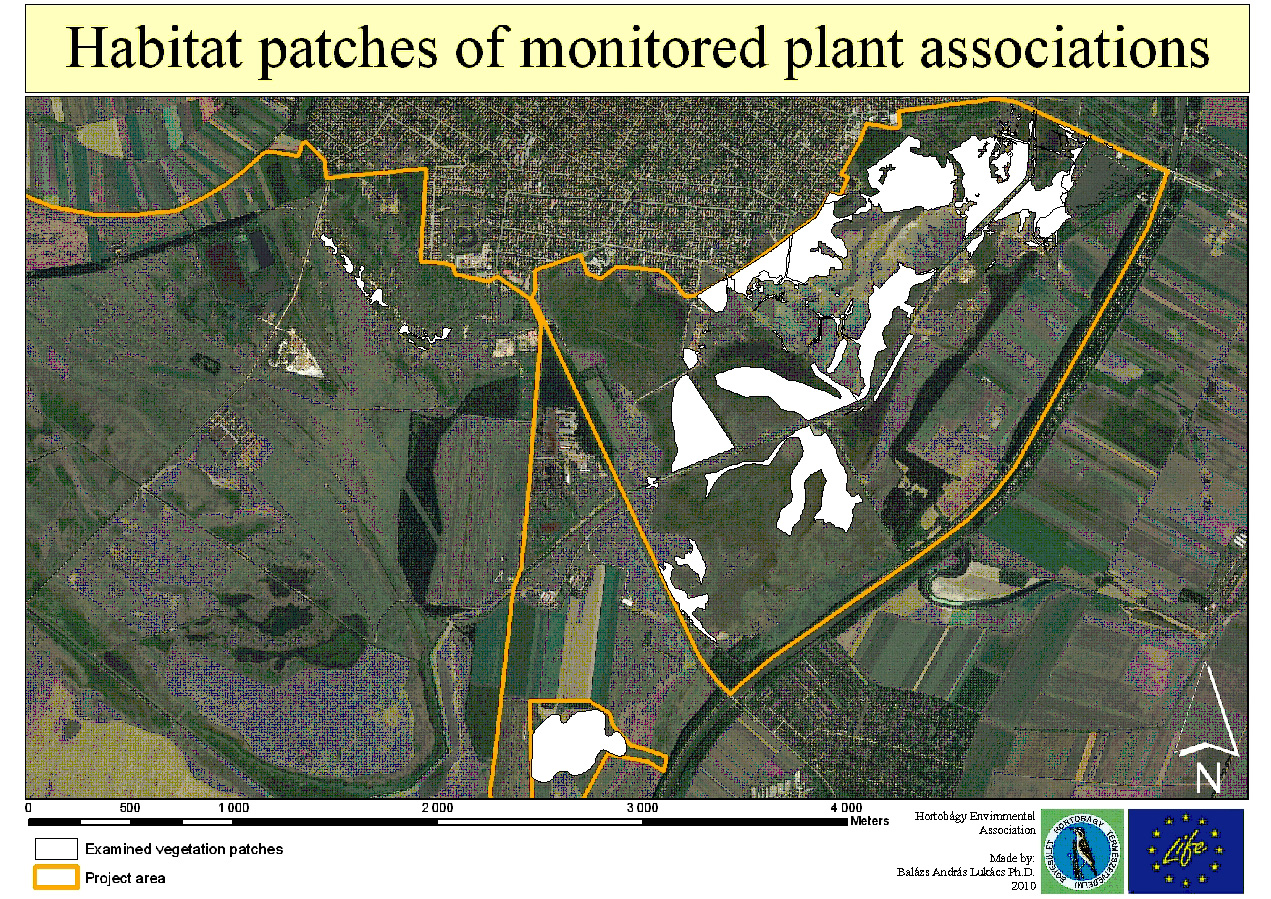
ACTION: E.3:
Monitoring of plant associations
The aim of the action is the verification of the restoration’s effect on sodic lakes’ characteristics with the changes of sodic patches’ plant assiciation coverage.
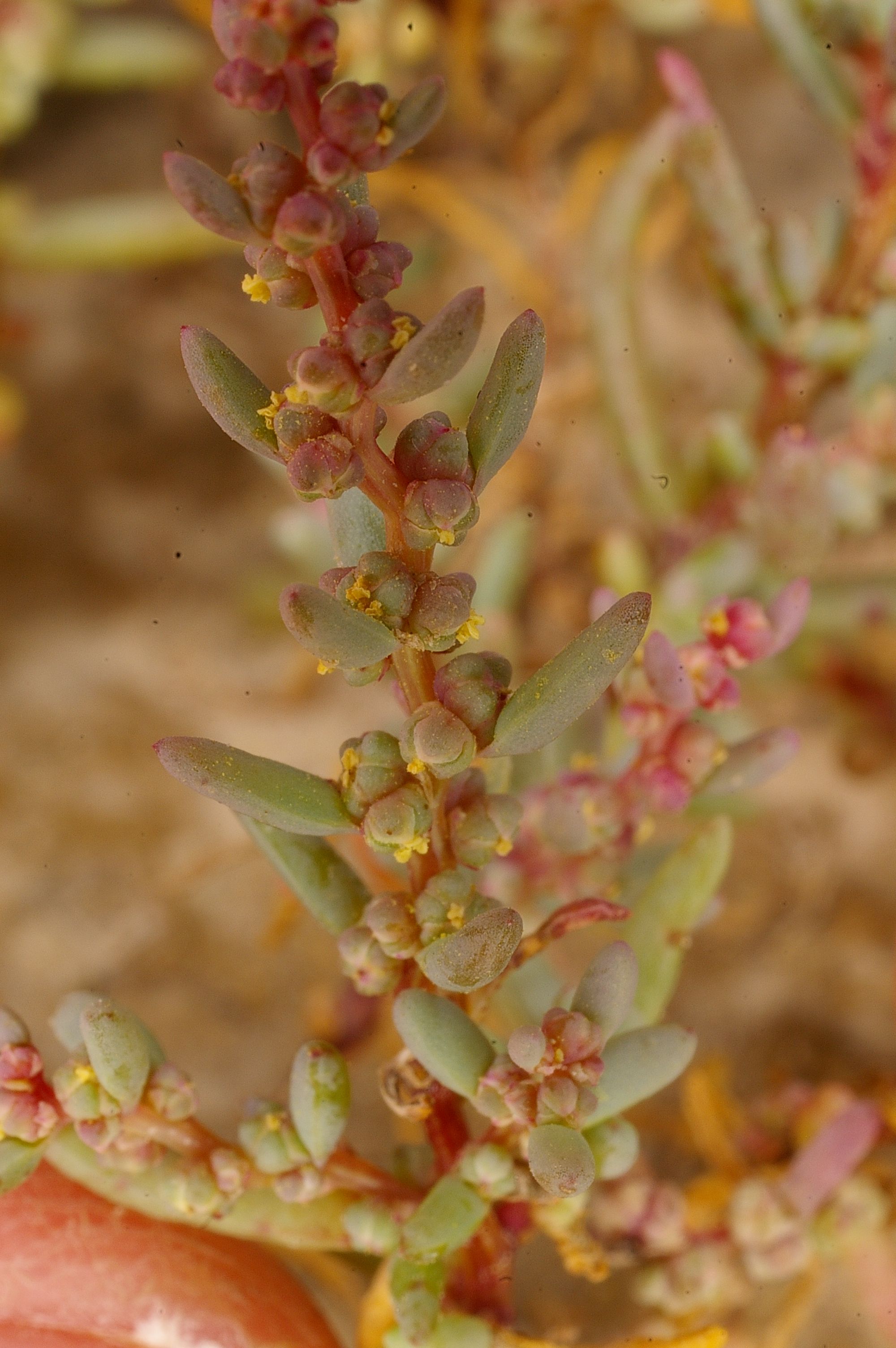

Photos: Suaeda maritima (on the left) and Verbena supina (on the right) on the project site (Photo: Balázs Lukács)
In 2009: The first habitat mapping of plant associations of Nagy-szik and Magdolna-puszta were executed in this year. This habitat map can be considered the basic surveying of the site before habitat restoration works. The mapping was executed in small scale (1:2000) because of tracing and introducing the expected changes in the coverage of sodic patches. According to the project proposal the coverage of Camphorosmo-Salicornietalia and Crypsidetalia aculeatae orders of the Thero-Suaedetea class and the Nanocyperetalia order of the Isoёto-Nanojuncetea class were measured with the mapping. The quantified coverage of the surveyed associations can be seen in the table and map below.
Hungarian name |
Scientific or English name |
Area covered (m²) |
Csupasz tómeder fenék |
Bare sodic pan bed |
|
Sziksófűtársulás |
Salicornietum prostratae |
0 |
Szolonyec vaksziknövényzet |
Camphorosmetum annuae |
0 |
Bajuszpázsitos-sziki sóballás |
Crypsido aculeatae-Suaedetum maritimae |
0 |
Magyar sóballás |
Suaedetum pannonicae |
22 615 |
Bajuszpázsitgyep |
Crypsidetum aculeatae |
127 738 |
Dárdás-labodás szoloncsák társulás |
Atriplicetum prostratae |
0 |
Karcsú bajuszfüves |
Heleochloetum alopecuroidis |
0 |
Vastag bajuszfüves |
Heleochloetum schoenoides |
0 |
Faluszéli libatopos |
Chenopodietum urbici |
0 |
Látonyás iszapfű-társulások |
Elatini-Lindernenion |
0 |
Henye vasfüves |
Heliotropio-Verbenetum supinae |
1 542 |
|
|
|
Total coverage of the surveyed associations |
|
151 895 |

In 2010: the second habitat mappings of plant associations of Nagy-szik and Magdolna-puszta were executed this year. This 2010 habitat map can be considered as a basic survey before the habitat restoration in extremly wet conditions. The 2010 precipitation was around 1400 mm in Balmazújváros which has to be compared with an average of 500-550 mm. In the meantime the impact of the ecologically high level of grazing on the plant associations carried out by the project cannot be neglected. The mapping was executed in small scale (1:2000) because of tracing and introducing the expected changes in the coverage of sodic patches. According to the project proposal the coverage of Camphorosmo-Salicornietalia and Crypsidetalia aculeatae orders of the Thero-Suaedetea class and the Nanocyperetalia order of the Isoёto-Nanojuncetea class were measured with the mapping. The quantified coverage of the surveyed associations can be seen in the table and map below.
As a result of the most unusual weather conditions causing three times the average precipitation large parts of the project site, especially Nagy-szik was covered with sahllow water. These areas with long periods of water cover became bare sodic patches and even the most pioneer associations could not develope until late autumn.
Hungarian name |
Scientific or English name |
Area covered (m²) |
Csupasz tómeder fenék |
Bare sodic pan bed |
844 815 |
Sziksófűtársulás |
Salicornietum prostratae |
0 |
Szolonyec vaksziknövényzet |
Camphorosmetum annuae |
0 |
Bajuszpázsitos-sziki sóballás |
Crypsido aculeatae-Suaedetum maritimae |
9 628 |
Magyar sóballás |
Suaedetum pannonicae |
0 |
Bajuszpázsitgyep |
Crypsidetum aculeatae |
134 617 |
Dárdás-labodás szoloncsák társulás |
Atriplicetum prostratae |
0 |
Karcsú bajuszfüves |
Heleochloetum alopecuroidis |
0 |
Vastag bajuszfüves |
Heleochloetum schoenoides |
0 |
Faluszéli libatopos |
Chenopodietum urbici |
0 |
Látonyás iszapfű-társulások |
Elatini-Lindernenion |
0 |
Henye vasfüves |
Heliotropio-Verbenetum supinae |
0 |
|
|
|
Total coverage of the surveyed associations |
|
989 060 |
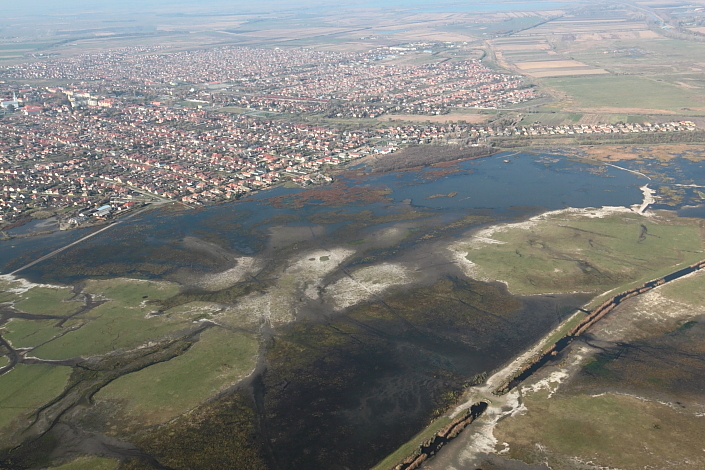
Picture: Aerial view of Nagy-szik where the sodic patches can be seen (Photo: János Oláh)
In 2011: The third habitat mappings of plant associations of Nagy-szik and Magdolna-puszta were executed this year. Since the second mapping which was carried out in extremely wet conditions the precipitation was well below the yearly average. This is why the area dried out considerably by the second half of 2011. In the dried out areas first bare soda patches were left as the vegetation perished after the water level. Later the original vegetation came back but it was not as extensive as it was. Also because of the very wet year in 2011 some species were more abundant and even changed the association type. Such species were the Suaeda maritima, Spergularia salina, Spergularia maritima, Heliotropium supinum, Verbena supina.
The mapping was executed in small scale (1:2000) because of tracing and introducing the expected changes in the coverage of sodic patches. According to the project proposal the coverage of Camphorosmo-Salicornietalia and Crypsidetalia aculeatae orders of the Thero-Suaedetea class and the Nanocyperetalia order of the Isoёto-Nanojuncetea class were measured with the mapping. The quantified coverage of the surveyed associations can be seen in the table and map below.
In the meantime the impact of the ecologically sustainable high level of grazing on the plant associations carried out by the project cannot be neglected and also did help to create more bare sodic patches.
Hungarian name |
Scientific or English name |
Area covered in 2011 (m2) |
Csupasz tómeder fenék |
Bare sodic pan bed |
852 378 |
Sziksófűtársulás |
Salicornietum prostratae |
0 |
Szolonyec vaksziknövényzet |
Camphorosmetum annuae |
0 |
Bajuszpázsitos-sziki sóballás |
Crypsido aculeatae-Suaedetum maritimae |
44 613 |
Magyar sóballás |
Suaedetum pannonicae |
0 |
Bajuszpázsitgyep |
Crypsidetum aculeatae |
101 559 |
Dárdás-labodás szoloncsák társulás |
Atriplicetum prostratae |
0 |
Karcsú bajuszfüves |
Heleochloetum alopecuroidis |
0 |
Vastag bajuszfüves |
Heleochloetum schoenoides |
0 |
Faluszéli libatopos |
Chenopodietum urbici |
0 |
Látonyás iszapfű-társulások |
Elatini-Lindernenion |
0 |
Henye vasfüves |
Heliotropio-Verbenetum supinae |
4 560 |
|
|
|
Total coverage of the surveyed associations |
|
1 003 110 |
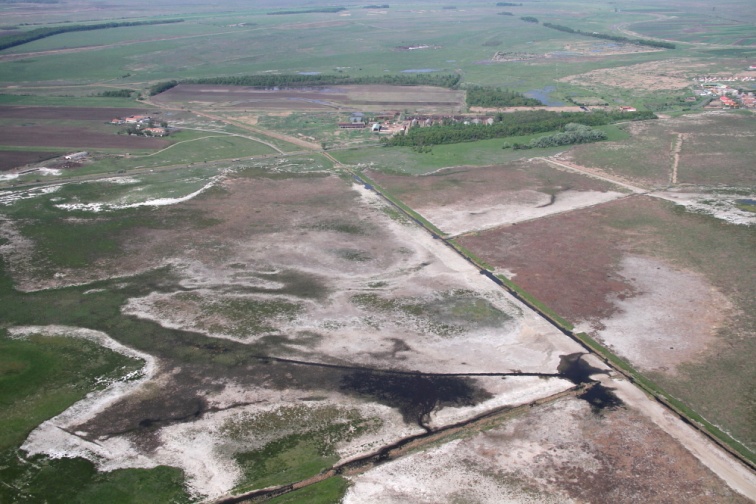
Picture: Aerial view of Nagy-szik where the sodic patches can be seen (Photo: János Oláh)
In 2012:The fourth habitat mappings of plant associations of Nagy-szik and Magdolna-puszta were executed this year. In 2010 the mapping was carried out in extremely wet conditions while in 2011 the precipitation was well below the yearly average (especially in the second half of the year). 2012 was extremely dry throughout and the entire area dried out by summer. Compared to the 2011 survey most of the bare soda patches were recolonized and the abundance of some species decreased drastically such as Suaeda maritima, Heliotropium supinum, Verbena supine. Other species however like Puccinellia limosa, Spergularia salina, Spergularia maritima became more common as they have better adaptability. Especially obvious was the increase of Puccinellia limosa from 34 to 47 hectares in just one year. Almost all bare soda patches of 2011 were covered by 40-70% of this species in 2012.
The mapping was executed in small scale (1:2000) because of tracing and introducing the expected changes in the coverage of sodic patches. According to the project proposal the coverage of Camphorosmo-Salicornietalia and Crypsidetalia aculeatae orders of the Thero-Suaedetea class and the Nanocyperetalia order of the Isoёto-Nanojuncetea class were measured with the mapping. The quantified coverage of the surveyed associations can be seen in the table and map below.
Hungarian name |
Scientific or English name |
Area covered in 2012 (m2) |
Csupasz tómeder fenék |
Bare sodic pan bed |
137 249 |
Sziksófűtársulás |
Salicornietum prostratae |
0 |
Szolonyec vaksziknövényzet |
Camphorosmetum annuae |
0 |
Bajuszpázsitos-sziki sóballás |
Crypsido aculeatae-Suaedetum maritimae |
4494 |
Magyar sóballás |
Suaedetum pannonicae |
0 |
Bajuszpázsitgyep |
Crypsidetum aculeatae |
104 349 |
Dárdás-labodás szoloncsák társulás |
Atriplicetum prostratae |
0 |
Karcsú bajuszfüves |
Heleochloetum alopecuroidis |
0 |
Vastag bajuszfüves |
Heleochloetum schoenoides |
0 |
Faluszéli libatopos |
Chenopodietum urbici |
0 |
Látonyás iszapfű-társulások |
Elatini-Lindernenion |
0 |
Henye vasfüves |
Heliotropio-Verbenetum supinae |
4 560 |
|
|
|
Total coverage of the surveyed associations |
|
250 652 |
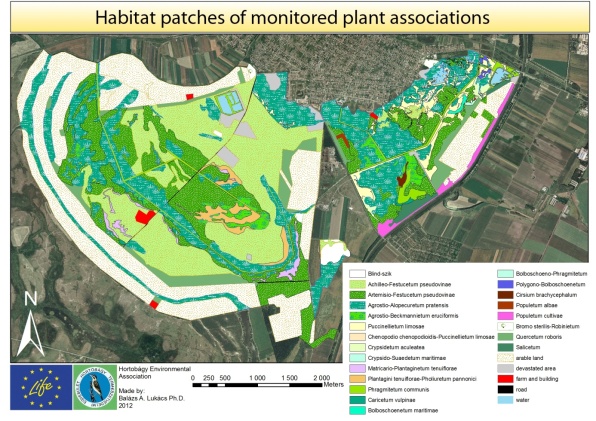
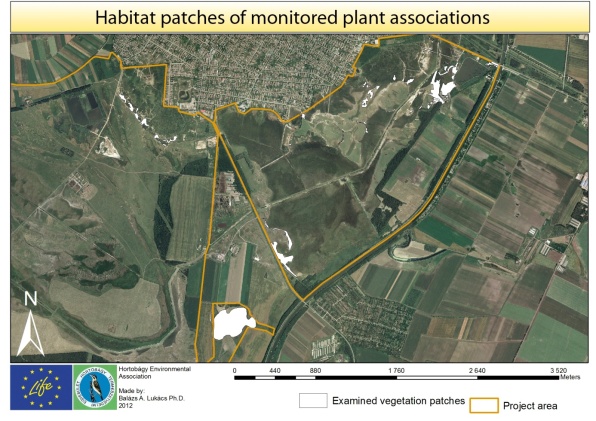
2013: Prior to the 2013 rehabilitation the status of the habitats changed significantly during the years with extreme precipitation.
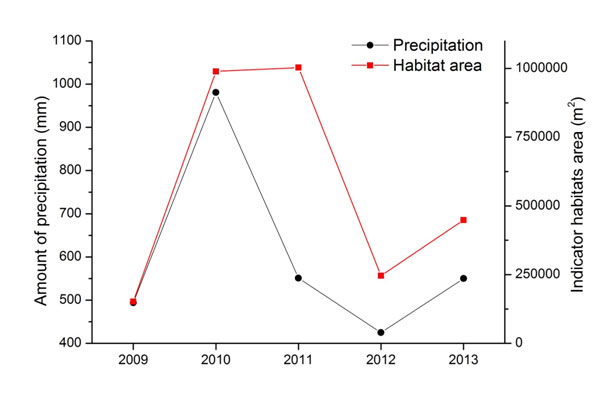
Figure: The change of size of the indicator habitat type during the project
Table: Extent of typical sodic plant association during the project
|
Hungarian name |
Scientific name |
cover 2009 (m2) |
cover 2010 (m2) |
cover 2011 (m2) |
cover 2012 (m2) |
cover 2013 (m2) |
|
Csupasz tómeder fenék |
Vakszik |
0 |
842285 |
852 378 |
132 929 |
333100 |
|
Sziksófűtársulás |
Salicornietum prostratae |
0 |
0 |
0 |
0 |
0 |
|
Szolonyec vaksziknövényzet |
Camphorosmetum annuae |
0 |
0 |
0 |
0 |
0 |
|
Bajuszpázsitos-sziki sóballás |
Crypsido aculeatae-Suaedetum maritimae |
0 |
9 628 |
44 613 |
4 494 |
35 929 |
|
Magyar sóballás |
Suaedetum pannonicae |
22 615 |
0 |
0 |
0 |
0 |
|
Bajuszpázsitgyep |
Crypsidetum aculeatae |
127 738 |
134 617 |
101 559 |
104 349 |
72 914 |
|
Dárdás-labodás szoloncsák társulás |
Atriplicetum prostratae |
0 |
0 |
0 |
0 |
0 |
|
Karcsú bajuszfüves |
Heleochloetum alopecuroidis |
0 |
0 |
0 |
0 |
0 |
|
Vastag bajuszfüves |
Heleochloetum schoenoides |
0 |
0 |
0 |
0 |
0 |
|
Faluszéli libatopos |
Chenopodietum urbici |
0 |
0 |
0 |
0 |
0 |
|
Látonyás iszapfű-társulások |
Elatini-Lindernenion |
0 |
0 |
0 |
0 |
0 |
|
Henye vasfüves |
Heliotropio-Verbenetum supinae |
1 542 |
2 530 |
4 560 |
4 320 |
6 510 |
|
total |
151 877 |
989 060 |
1 003 110 |
246 092 |
448 453 |
|

